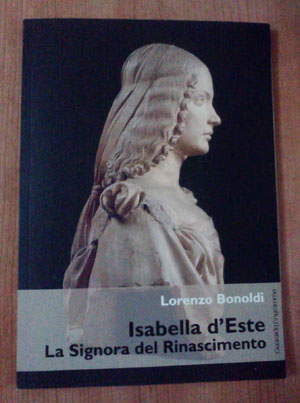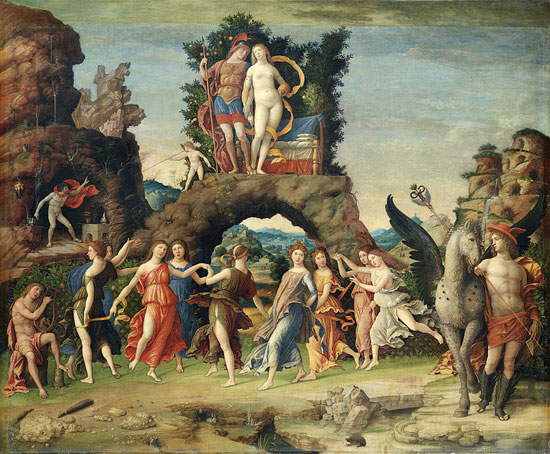It is not easy to keep a reader glued to a book about the relationship between Isabella d’Este and the arts: because the subject matter is not the easiest, because the history of the Mantuan Renaissance is much less well known than that of other renaissances that have enjoyed greater public acclaim, and because often, in the history of art, subjects that are too circumscribed risk, wrongly, being seen as the stuff of specialists. Isabella d’Este. The Lady of the Renaissance, published by Gualandi, is a book that overcomes all these clichés. And I do not say this because Lorenzo Bonoldi, the author, is a friend: I say it because from the very first lines one can sense the passion Lorenzo has put into tackling this subject. And after all, if the Marquise of Mantua has been the subject of Lorenzo Bonoldi’s research since his university studies, it means that at the basis of the book there is not only a strong attachment, but also a multi-year work.
 |
| Isabella d’Este. The Lady of the Renaissance, by Lorenzo Bonoldi |
Great attention, in this first section of the book, is devoted to the paintings commissioned for the Ducal Palace studiolo: the events that led to the realization of the works are traced, and the iconographic program behind them is analyzed, with Isabella d’Este who, simplifying and trivializing, figures as the Heavenly Venus who rules, together with her husband Francesco II Gonzaga (who in one painting takes on the guise of the god Mars) with justice and love for the arts, shuns vices by chasing them away from the garden of virtues, and from Venus herself receives the coronation as a seal of her gifts. A discussion of Isabella d’Este would also be incomplete without adequate mention of the many portraits the marquise commissioned from the most illustrious artists of her time: again, Lorenzo Bonoldi analyzes well-known and lesser-known portraits in order to make the reader perceive how much the desire for immortality and eternal youth had always been a constant in the relationship between Isabella d’Este and the arts.
 |
| Andrea Mantegna, Parnassus (1496-1497; Paris, Louvre). Painting made for the studiolo of Isabella d’Este. |
The next chapter is devoted to the relationship between the marquise and Leonardo da Vinci: a relationship centered entirely on the very famous portrait (...always here we come back) that was never made but of which the Louvre, at its Graphic Arts Department, preserves the cartoon that has given us what is perhaps the most famous image of Isabella d’Este. A cartoon whose fortune, moreover, is testified by the numerous copies that were made of it, as well as by the works that were inspired by that cartoon: one example is theAngel by Leonardo’s Giovanni Ambrogio de’ Predis preserved at the National Gallery in London, to which the third section of the book is dedicated and which, although not derived from a direct use of Leonardo’s cartoon, as the author lets us know, would nevertheless have been made from the original model transferred and adapted to the dimensions of the support used by de’ Predis. Similarly, from the same cartoon in the Louvre would derive a painting recently rediscovered and therefore risen to the headlines for a hypothetical and unlikely attribution to Leonardo himself: the portrait of Isabella d’Este in the guise of Saint Catherine of Alexandria that appeared in Switzerland a couple of years ago and about which we also dealt with on our website to provide some small evidence that could disprove excessively resounding attributions. Lorenzo Bonoldi is of the same opinion, who cautiously assigns the portrait to Leonardo’s workshop and hypothesizes that the master, overburdened with work, had refused to make it himself but had nevertheless decided to supervise its execution and, dissatisfied with the poor result obtained, would not have sent it to the marquise and would have “recycled” it as a devotional painting. The author’s hypothesis is supported by the fact that the pigments used by the painting would be the same as those used by Leonardo, and that the priming of the canvas was done according to the typical Leonardo procedure.
The concluding chapter is devoted to the so-called medal of Isabella d’Este, a celebratory object that has always been a worry for art historians who have struggled to interpret the feat and motto that appear on the verso of the artifact. By comparing the medal with coeval and ancient works and referring to the study of the sources, Lorenzo Bonoldi tries to suggest a suggestive interpretation of the allegory’s meaning.
Isabella d’Este. La signora del Rinascimento, halfway between a popular book, whose timing and language the volume maneuvers with remarkable confidence, and a research essay, enriches the bibliography on the marchioness of Mantua in a valuable way and offers a valid, agile, quality contribution and, as we said, written with great passion, to spread knowledge of the Mantuan Renaissance, as well as that of one of the greatest, most refined and cultured patrons that the history of art has known. It is a true art history book: suitable for both the expert and the enthusiast, rich in color images (one of the book’s merits is that each of the author’s remarks is adequately supported by pictures), endowed with a clear and elegant prose that leaves nothing to chance, skips no logical passages and constantly puts the reader in a position to follow precisely the author’s thoughts and hypotheses. And a volume that, we can confidently say, represents one of the most interesting publishing novelties of the first months of the year. To be read with great interest.
Isabella d’Este. The Lady of the Renaissance
by Lorenzo Bonoldi
published by Gualandi
91 pages
14,90
Warning: the translation into English of the original Italian article was created using automatic tools. We undertake to review all articles, but we do not guarantee the total absence of inaccuracies in the translation due to the program. You can find the original by clicking on the ITA button. If you find any mistake,please contact us.